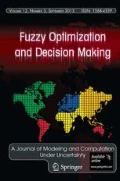Abstract
The eigenvector method is one of the most used methods for deriving priorities of objects from multiplicative pairwise comparison matrices in Analytic Hierarchy Process (AHP). Fuzzy extension of AHP has been of much attention in order to capture uncertainty stemming from subjectivity of human thinking and from incompleteness of information that are integral to multi-criteria decision-making problems. Various fuzzy extensions of the eigenvector method have been introduced in order to derive fuzzy priorities of objects from fuzzy multiplicative pairwise comparison matrices. These fuzzy extensions are critically reviewed in this paper, and it is showed that (i) they violate multiplicative reciprocity of the related pairwise comparisons, (ii) they are not invariant under permutation of objects, (iii) the fuzzy maximal eigenvectors are not normalized, or (iv) a given normalized fuzzy maximal eigenvector does not consist of normalized maximal eigenvectors obtainable from multiplicative pairwise comparison matrices forming the fuzzy multiplicative pairwise comparison matrices. Afterwards, a new fuzzy extension of the eigenvector method based on the constrained fuzzy arithmetic is introduced and it is shown that it satisfies all four desirable properties.

Similar content being viewed by others
References
Blaquero, R., Carrizosa, E., & Conde, E. (2006). Inferring efficient weights from pairwise comparison matrices. Mathematical Methods of Operations Research, 64(2), 271.
Crawford, G., & Williams, C. (1985). A note on the analysis of subjective judgment matrices. Journal of Mathematical Psychology, 29(2), 387.
Csutora, R., & Buckley, J. J. (2001). Fuzzy hierarchical analysis: The lambda-max method. Fuzzy Sets and Systems, 120(2), 181.
Dijkstra, T. K. (2013). On the extraction of weights from pairwise comparison matrices. Central European Journal of Operational Research, 21(1), 103.
Enea, M., & Piazza, T. (2004). Project selection by constrained fuzzy AHP. Fuzzy Optimization and Decision Making, 3(1), 39.
Fedrizzi, M., & Krejčí, J. (2015). A note on the paper ‘Fuzzy analytic hierarchy process: Fallacy of the popular methods’. International Journal of Uncertainty, Fuzziness and Knowledge-Based Systems, 23(6), 965.
Fichtner, J. (1986). On deriving priority vectors from matrices of pairwise comparisons. Socio-Economic Planning Sciences, 20(6), 341.
Goyal, R. K., & Kaushal, S. (2017). Deriving crisp and consistent priorities for fuzzy AHP-based multicriteria systems using non-linear constrained optimization. Fuzzy Optimization and Decision Making. https://doi.org/10.1007/s10700-017-9267-y.
Ishizaka, A. (2014). Comparison of fuzzy logic, AHP, FAHP and hybrid fuzzy AHP for new supplier selection and its performance analysis. International Journal of Integrated Supply Management, 9(1–2), 1.
Kaufmann, A., & Gupta, M. M. (1991). Introduction to fuzzy arithmetic: Theory and applications. Boston: International Thomson Computer Press.
Klir, G. J., & Pan, Y. (1998). Constrained fuzzy arithmetic: Basic questions and some answers. Soft Computing, 2(2), 100.
Krejčí, J. (2017a). Additively reciprocal fuzzy pairwise comparison matrices and multiplicative fuzzy priorities. Soft Computing, 21(12), 3177. https://doi.org/10.1007/s00500-015-2000-2.
Krejčí, J. (2017b). Fuzzy eigenvector method for obtaining normalized fuzzy weights from fuzzy pairwise comparison matrices. Fuzzy Sets and Systems, 315(1), 26.
Krejčí, J., Pavlačka, O., & Talašová, J. (2017). A fuzzy extension of analytic hierarchy process based on the constrained fuzzy arithmetic. Fuzzy Optimization and Decision Making, 16(1), 89.
Laarhoven, P. J. M. V., & Pedrycz, W. (1983). A fuzzy extension of Saaty’s priority theory. Fuzzy Sets and Systems, 11(1–3), 199.
Liao, H. C., Mi, X. M., Xu, Z. S., Xu, J. P., & Herrera, F. (2018). Intuitionistic fuzzy analytic network process. IEEE Transactions on Fuzzy Systems. https://doi.org/10.1109/TFUZZ.2017.2788881.
Saaty, T. L. (1980). The Analytic Hierarchy Process. New York: McGraw Hill.
Saaty, T. L. (2006). There is no mathematical validity for using fuzzy number crunching in the analytic hierarchy process. Journal of Systems Science and Systems Engineering, 15(4), 457.
Saaty, T. L., & Hu, G. (1998). Ranking by eigenvector versus other methods in the analytic hierarchy process. Applied Mathematics Letters, 11(4), 121.
Saaty, T. L., & Vargas, L. G. (1984). Comparison of eigenvalue, logarithmic least squares and least squares methods in estimating ratios. Mathematical Modelling, 5(5), 309.
Urena, R., Chiclana, F., Morente-Molinera, J. A., & Herrera-Viedma, F. (2015). Managing incomplete preference relations in decision making: A review and future trends. Information Sciences, 302(1), 14.
Wang, Y. M., & Chin, K. S. (2006). An eigenvector method for generating normalized interval and fuzzy weights. Applied Mathematics and Computation, 181(2), 1257.
Wang, Y. M., & Elhag, T. M. S. (2006). On the normalization of interval and fuzzy weights. Fuzzy Sets and Systems, 157(18), 2456.
Xu, Z. S., & Liao, H. C. (2017). Intuitionistic fuzzy analytic hierarchy process. IEEE Transactions on Fuzzy Systems, 22(4), 749.
Zhü, K. (2014). Fuzzy analytic hierarchy process: Fallacy of the popular methods. European Journal of Operational Research, 236(1), 209.
Author information
Authors and Affiliations
Corresponding author
Rights and permissions
About this article
Cite this article
Siebert, J. Fuzzy eigenvector method for deriving normalized fuzzy priorities from fuzzy multiplicative pairwise comparison matrices. Fuzzy Optim Decis Making 18, 175–197 (2019). https://doi.org/10.1007/s10700-018-9291-6
Published:
Issue Date:
DOI: https://doi.org/10.1007/s10700-018-9291-6
Keywords
- Fuzzy maximal eigenvector
- Fuzzy maximal eigenvalue
- Normalized fuzzy priorities
- Constrained fuzzy arithmetic
- Fuzzy pairwise comparison matrix




